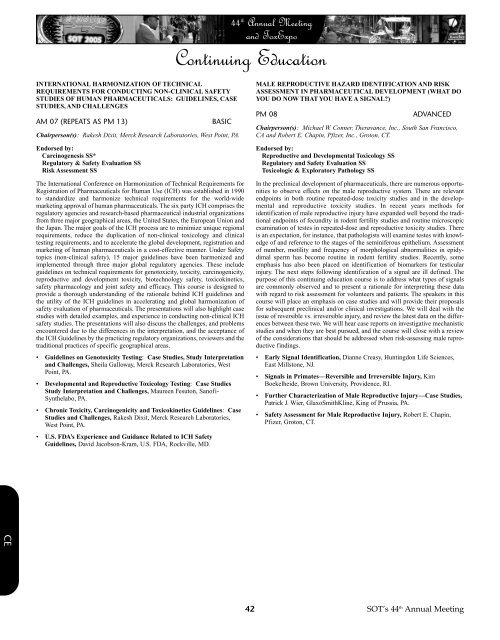Program - Society of Toxicology
Program - Society of Toxicology
Program - Society of Toxicology
You also want an ePaper? Increase the reach of your titles
YUMPU automatically turns print PDFs into web optimized ePapers that Google loves.
44 th Annual Meeting<br />
and ToxExpo<br />
Continuing Education<br />
INTERNATIONAL HARMONIZATION OF TECHNICAL<br />
REQUIREMENTS FOR CONDUCTING NON-CLINICAL SAFETY<br />
STUDIES OF HUMAN PHARMACEUTICALS: GUIDELINES, CASE<br />
STUDIES, AND CHALLENGES<br />
AM 07 (REPEATS AS PM 13)<br />
BASIC<br />
Chairperson(s): Rakesh Dixit, Merck Research Laboratories, West Point, PA.<br />
Endorsed by:<br />
Carcinogenesis SS*<br />
Regulatory & Safety Evaluation SS<br />
Risk Assessment SS<br />
The International Conference on Harmonization <strong>of</strong> Technical Requirements for<br />
Registration <strong>of</strong> Pharmaceuticals for Human Use (ICH) was established in 1990<br />
to standardize and harmonize technical requirements for the world-wide<br />
marketing approval <strong>of</strong> human pharmaceuticals. The six party ICH comprises the<br />
regulatory agencies and research-based pharmaceutical industrial organizations<br />
from three major geographical areas, the United States, the European Union and<br />
the Japan. The major goals <strong>of</strong> the ICH process are to minimize unique regional<br />
requirements, reduce the duplication <strong>of</strong> non-clinical toxicology and clinical<br />
testing requirements, and to accelerate the global development, registration and<br />
marketing <strong>of</strong> human pharmaceuticals in a cost-effective manner. Under Safety<br />
topics (non-clinical safety), 15 major guidelines have been harmonized and<br />
implemented through three major global regulatory agencies. These include<br />
guidelines on technical requirements for genotoxicity, toxicity, carcinogenicity,<br />
reproductive and development toxicity, biotechnology safety, toxicokinetics,<br />
safety pharmacology and joint safety and efficacy. This course is designed to<br />
provide a thorough understanding <strong>of</strong> the rationale behind ICH guidelines and<br />
the utility <strong>of</strong> the ICH guidelines in accelerating and global harmonization <strong>of</strong><br />
safety evaluation <strong>of</strong> pharmaceuticals. The presentations will also highlight case<br />
studies with detailed examples, and experience in conducting non-clinical ICH<br />
safety studies. The presentations will also discuss the challenges, and problems<br />
encountered due to the differences in the interpretation, and the acceptance <strong>of</strong><br />
the ICH Guidelines by the practicing regulatory organizations, reviewers and the<br />
traditional practices <strong>of</strong> specific geographical areas.<br />
• Guidelines on Genotoxicity Testing: Case Studies, Study Interpretation<br />
and Challenges, Sheila Galloway, Merck Research Laboratories, West<br />
Point, PA.<br />
• Developmental and Reproductive <strong>Toxicology</strong> Testing: Case Studies<br />
Study Interpretation and Challenges, Maureen Fesuton, San<strong>of</strong>i-<br />
Synthelabo, PA.<br />
• Chronic Toxicity, Carcinogenicity and Toxicokinetics Guidelines: Case<br />
Studies and Challenges, Rakesh Dixit, Merck Research Laboratories,<br />
West Point, PA.<br />
• U.S. FDA’s Experience and Guidance Related to ICH Safety<br />
Guidelines, David Jacobson-Kram, U.S. FDA, Rockville, MD.<br />
MALE REPRODUCTIVE HAZARD IDENTIFICATION AND RISK<br />
ASSESSMENT IN PHARMACEUTICAL DEVELOPMENT (WHAT DO<br />
YOU DO NOW THAT YOU HAVE A SIGNAL?)<br />
PM 08<br />
ADVANCED<br />
Chairperson(s): Michael W. Conner, Theravance, Inc., South San Francisco,<br />
CA and Robert E. Chapin, Pfizer, Inc., Groton, CT.<br />
Endorsed by:<br />
Reproductive and Developmental <strong>Toxicology</strong> SS<br />
Regulatory and Safety Evaluation SS<br />
Toxicologic & Exploratory Pathology SS<br />
In the preclinical development <strong>of</strong> pharmaceuticals, there are numerous opportunities<br />
to observe effects on the male reproductive system. There are relevant<br />
endpoints in both routine repeated-dose toxicity studies and in the developmental<br />
and reproductive toxicity studies. In recent years methods for<br />
identification <strong>of</strong> male reproductive injury have expanded well beyond the traditional<br />
endpoints <strong>of</strong> fecundity in rodent fertility studies and routine microscopic<br />
examination <strong>of</strong> testes in repeated-dose and reproductive toxicity studies. There<br />
is an expectation, for instance, that pathologists will examine testes with knowledge<br />
<strong>of</strong> and reference to the stages <strong>of</strong> the seminiferous epithelium. Assessment<br />
<strong>of</strong> number, motility and frequency <strong>of</strong> morphological abnormalities in epidydimal<br />
sperm has become routine in rodent fertility studies. Recently, some<br />
emphasis has also been placed on identification <strong>of</strong> biomarkers for testicular<br />
injury. The next steps following identification <strong>of</strong> a signal are ill defined. The<br />
purpose <strong>of</strong> this continuing education course is to address what types <strong>of</strong> signals<br />
are commonly observed and to present a rationale for interpreting these data<br />
with regard to risk assessment for volunteers and patients. The speakers in this<br />
course will place an emphasis on case studies and will provide their proposals<br />
for subsequent preclinical and/or clinical investigations. We will deal with the<br />
issue <strong>of</strong> reversible vs. irreversible injury, and review the latest data on the differences<br />
between these two. We will hear case reports on investigative mechanistic<br />
studies and when they are best pursued, and the course will close with a review<br />
<strong>of</strong> the considerations that should be addressed when risk-assessing male reproductive<br />
findings.<br />
• Early Signal Identification, Dianne Creasy, Huntingdon Life Sciences,<br />
East Millstone, NJ.<br />
• Signals in Primates—Reversible and Irreversible Injury, Kim<br />
Boekelheide, Brown University, Providence, RI.<br />
• Further Characterization <strong>of</strong> Male Reproductive Injury—Case Studies,<br />
Patrick J. Wier, GlaxoSmithKline, King <strong>of</strong> Prussia, PA.<br />
• Safety Assessment for Male Reproductive Injury, Robert E. Chapin,<br />
Pfizer, Groton, CT.<br />
CE<br />
42<br />
SOT’s 44 th Annual Meeting

















